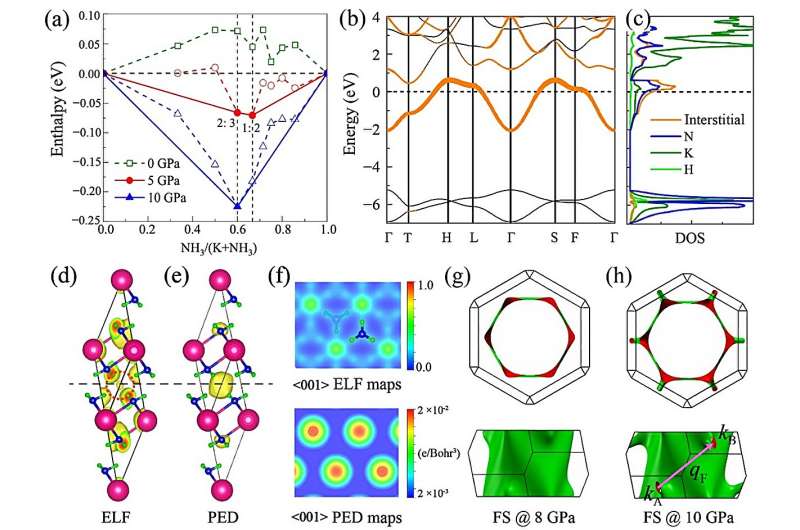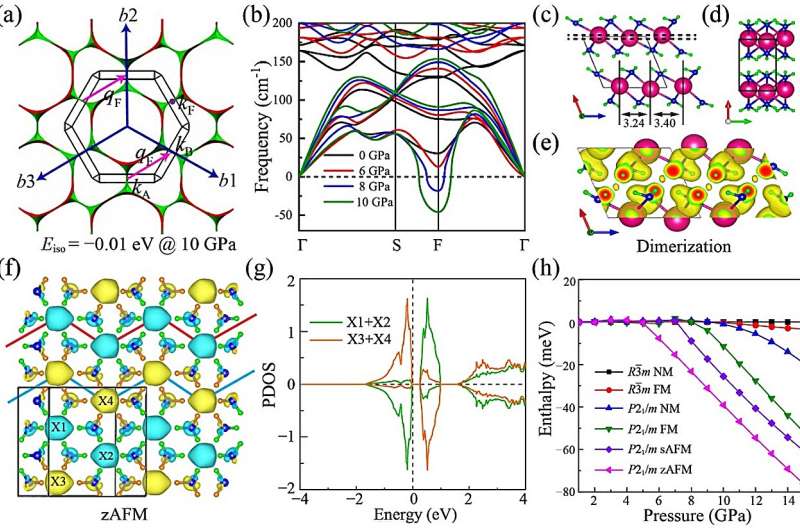This article has been reviewed according to Science X's editorial process and policies. Editors have highlighted the following attributes while ensuring the content's credibility:
fact-checked
trusted source
proofread
Quasi-2D spin-Peierls transition through interstitial anionic electrons in K(NH₃)₂

In a paper published in Science Bulletin, a Chinese team of scientists predicts a novel electride K(NH3)2, with interstitial electrons distributed at cages formed by six ammonia molecules and forming a quasi-2D triangular lattice. They have revealed that this material undergoes a spin-Peierls phase transition under moderate pressures.
This study was led by Prof. Jian Sun (National Laboratory of Solid State Microstructures, School of Physics and Collaborative Innovation Center of Advanced Microstructures, Nanjing University). The team employed their self-developed crystal structure prediction software MAGUS and performed first-principles calculations to determine the crystal structures of the potassium ammonia compound under moderate pressures, which has been recognized as electride at ambient condition for a long time.
Electron-phonon interactions and electron-electron correlations represent two crucial facets in condensed matter physics. In a model system of half-filled spin-1/2 anti-ferromagnetic chain, the lattice dimerization induced by electron-nucleus interaction can be intensified by onsite Coulomb repulsion, resulting into a spin-Peierls state. In two dimensions, however, the real material exhibiting such phenomena has never been found.
On the other hand, electrides are materials in which non-bound electrons occupy crystal voids and exhibit anionic behaviors (IAEs). It is well established that the correlations between spin-polarized IAEs and their coupling with adjacent nuclei could trigger more interesting quantum phenomena.
Up to now, however, there have been very few works exploring the interactions between the correlated IAEs and phonons. One of the main reasons is the large number of atoms in organic electrides, where most of the anti-ferromagnetic IAEs emerges.

The team identified that the R-3m K(NH3)2 achieves thermodynamic stability at about 2 GPa, which adopts a rhombohedral primitive cell, and the ammonia molecules are situated on both sides of potassium layers.
Some of the valence electrons are distributed within interlayer cavities surrounded by six hydrogen atoms, forming interstitial anionic electrons. The band crossing the Fermi level is primarily attributed to these IAEs, which exist as isolated entities with bridging ammonia molecules.
The researchers also explored the pressure effects on the phonon and electronic properties. The van-Hove singularities (VHSs) are brought to the Fermi level under higher pressure, which induces the Peierls-type instability and the dimerized structure. These VHSs also contribute to a step-like density of states, enhancing electron correlations and inducing magnetic instability. The magnetic ground state is found to be zigzag type anti-ferromagnetism, which can be described by the Heisenberg model with modulated nearest-neighboring magnetic interactions.
More importantly, first-principles calculations reveal that magnetic and Peierls instability not only coexist, but also exhibit a positive interplay, constituting a scenario of spin-Peierls transition unprecedented in a realistic 2D material, particularly involving IAEs.
"It is very intriguing to reveal such abundant physical phenomena in a realistic material. The interactions between correlated IAEs and phonons can provide inspirations for the exploration of magnetic interactions, structural distortions, and charge density waves," Jian says.
More information: Chi Ding et al, Quasi-2D spin-Peierls transition through interstitial anionic electrons in K(NH3)2, Science Bulletin (2024). DOI: 10.1016/j.scib.2024.02.016
Provided by Science China Press





















